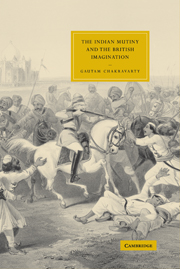Book contents
- Frontmatter
- Contents
- Acknowledgements
- Glossary
- Introduction
- 1 From chronicle to history
- 2 Reform and revision
- 3 Romances of empire, Romantic orientalism and Anglo-India: contexts, historical and literary
- 4 The ‘Mutiny’ novel and the historical archive
- 5 Counter-insurgency and heroism
- 6 Imagining resistance
- Epilogue
- Notes
- Bibliography
- Index list
- CAMBRIDGE STUDIES IN NINETEENTH-CENTURY LITERATURE AND CULTURE
6 - Imagining resistance
Published online by Cambridge University Press: 22 September 2009
- Frontmatter
- Contents
- Acknowledgements
- Glossary
- Introduction
- 1 From chronicle to history
- 2 Reform and revision
- 3 Romances of empire, Romantic orientalism and Anglo-India: contexts, historical and literary
- 4 The ‘Mutiny’ novel and the historical archive
- 5 Counter-insurgency and heroism
- 6 Imagining resistance
- Epilogue
- Notes
- Bibliography
- Index list
- CAMBRIDGE STUDIES IN NINETEENTH-CENTURY LITERATURE AND CULTURE
Summary
How little we even now know of the millions of Hindostan – their motives, their secrets, their animosities, their aspirations.
Chamber's History of the Indian Revolt (1859)I am off to the palace to see what has really happened; information's everything.
Jim Douglas in F. A. Steel, On the Face of the Waters (1896)INTELLIGENCE FAILURE AND THE VISIONS OF SUTURE
It was suggested in the last chapter that Jim Douglas's return to rebel Delhi in May 1857 to gather information, together with the fact that he lives in the city for over two months, represents a fantasy of surveillance projected on a site that otherwise lay beyond the colonial state between May and September that year. In so doing, On the Face of the Waters marks a significant literary-historical development. Whereas in Money's The Wife and the Ward, the world of the rebel beyond the all-too vulnerable walls of the Kanpur entrenchment appears only through its effect upon the garrison, in somewhat later novels such as James Grant's First Love and Last Love (1868), or George Chesney's The Dilemma (1876) that world appears alongside a besieged or beleaguered Anglo-India. But in the novels of the nineties and after, the two worlds are often energetically bridged by heroes such as Douglas, Sammy, Ashby and Jenetha who, as they pass unhampered between one and the other bearing information, mediate the representation of the rebel world in a manner not dissimilar to the iterological mediation of indigenous society and landscape in a fairly long tradition of British Indian travel writing.
- Type
- Chapter
- Information
- The Indian Mutiny and the British Imagination , pp. 156 - 180Publisher: Cambridge University PressPrint publication year: 2005

